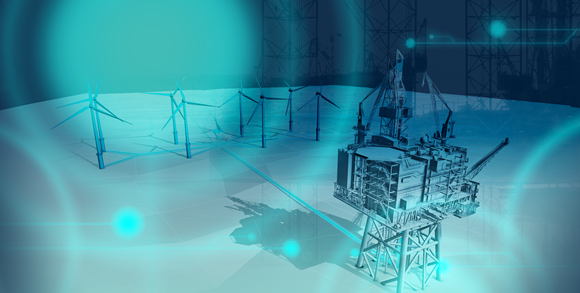
The UK Oil and Gas Authority on Monday said three winners would share a £1 million (~$1,32 million) prize for ideas that could help cut greenhouse gas emissions by moving forward the drive to electrify platforms in the North Sea.
The decarbonization competition for the electrification of offshore oil and gas installations was launched by the Oil and Gas Authority (OGA), working with BEIS, to fund technical and commercial studies on offshore electrification in the UK North Sea as part of the North Sea Transition Deal outcomes.
Three winners are Orcadian Energy (project lead), Ørsted (project lead), and Katon Engineering.
Orcadian Energy was awarded £466,667 million for innovative concepts for the electrification of offshore installations in the Central Graben (Award:£466,667).
Ørsted was awarded £239,360 for a project addressing technical and commercial requirements of windfarm connections with offshore installations.
Katoni Engineering was awarded £335,280 for an optimised interface for distributed offshore renewable sources supplying existing offshore installations with secure and low-emissions power.
The three companies must now complete work on their studies by March 31, 2022, with project reports to be published in Q2 2022
Dr Andy Samuel, OGA Chief Executive, said: "Rapid progress on platform electrification is vital to ensure that production emissions are halved by 2030, in line with agreed targets. "This competition has sparked significant interest from a broad cross-section of industry with an impressive range of innovative proposals. The investment and infrastructure to move projects forward now will be beneficial long into the future, enabling network grid and offshore wind expansion.”
Energy & Climate Change Minister Greg Hands said: "Through our landmark North Sea Transition Deal, we are ensuring the UK’s oil and gas industry’s highly-skilled workers and supply chain are protected as we shift to a lower-carbon future.
“These projects, supported with £1 million government funding, will drive forward plans for platform electrification, a key step in supporting the industry to decarbonize oil and gas production.”
Carlo Procaccini, OGA Head of Technology, said: "Decarbonisation of oil and gas operations is an industry imperative over the next decade, and platform electrification from renewable sources will be an effective way to achieve that.
“We were delighted with the strong industry interest in the £1m BEIS/OGA electrification competition and the quality of the winners’ submissions. The three chosen projects will assess innovative solutions to kickstart oil and gas electrification in the North Sea.”
According to the OGA, power generation accounts for over 70% of oil and gas production emissions. It is anticipated that powering installations using electricity, from a cable to the shore or from a nearby wind farm, could lead to a reduction of 2-3 million tonnes of CO2 a year – equivalent to the annual carbon emissions from households in a city the size of Liverpool, the OGA said.
"The OGA has been encouraging electrification opportunities in the Central North Sea and West of Shetland by bringing Operators together, hosting workshops with the power sector, and pressing Operators to move more quickly to deliver projects," the regulator said.
"Platform electrification plays an important role in the OGA’s vision for an integrated energy vision. The OGA’s Energy Integration Report found that the UK Continental Shelf could, through a mix of offshore electrification, carbon capture and storage, offshore wind power, and hydrogen, absorb up to 60% of the UK’s entire greenhouse gas reduction needed to achieve net zero emissions by 2050," the OGA added.
Winning applications
Orcadian Energy (project lead): Innovative concepts for the electrification of offshore installations in the Central Graben.
Orcadian Energy will evaluate innovative concepts for the electrification of key offshore installations in the Central Graben (e.g. not requiring an electrical connection to the shore) producing an industry report describing this approach. Orcadian’s proposed concept would use renewable energy, generated from local wind farms, for the bulk of the electricity required; with backup power generated from gas or net-zero fuels, supported by batteries for a fast response.
Based in the UK, Orcadian Energy is the operator of the proposed Pilot polymer flood project on the Western Platform of the Central North Sea and will receive support on this concept study from Crondall Energy (client engineer), Enertechnos (cable technology), Petrofac (EPC and O&M contractor), North Sea Midstream Partners (Infrastructure Investor), and Wärtsilä (power system supplier).
Orsted (project lead): Addressing technical and commercial requirements of windfarm connections with offshore installations.
This concept study will use Ørsted’s Hornsea offshore wind farm lease area and an existing gas platform in the Southern North Sea, to explore the optimal technical design for a stable and reliable power supply from an offshore wind farm. This would be an important step towards decarbonizing offshore installations as per the North Sea Transition Deal.
The four-month feasibility study will also investigate the commercial solutions for establishing an electrical connection between an offshore wind farm and other installations. The aim is to provide a solution that could be scaled, replicated, and applied to any wind farm and platform in proximity to one another. Ørsted will deliver this project working together with two partners, Neptune Energy and Goal7.
Ørsted is a global renewable energy developer and operator, supplying large-scale and cost-competitive offshore/onshore wind and solar energy solutions.
Katoni Engineering: An optimized interface for distributed offshore renewable sources supplying existing offshore installations with secure and low-emissions power.
The Katoni-led study will provide an assessment of how different sources and locations of renewable generation can be utilized by existing offshore assets on a large, repeatable scale, driving timeline and cost efficiencies. The work will address key concerns of oil and gas operators related to security of supply from a non-grid connected solution, by leveraging the scale and mix of the power network. This feasibility study will be of interest to multiple sectors of the energy market from Operators to electrical supply networks to offshore wind power operators.
Based in Aberdeen, Katoni Engineering is a specialist engineering company focused on offshore asset management and net-zero operations.



